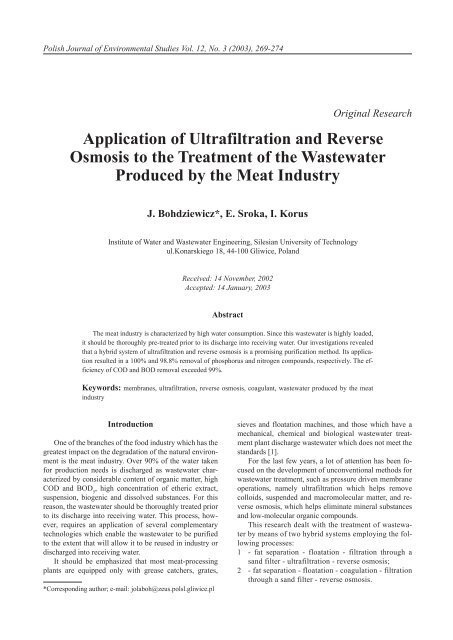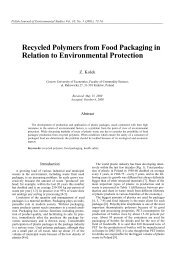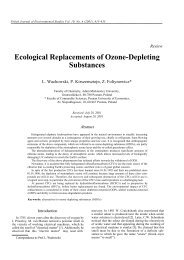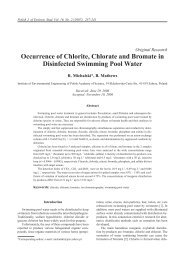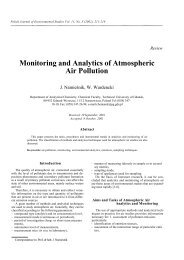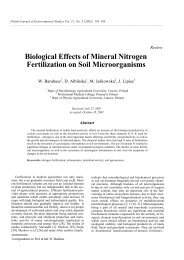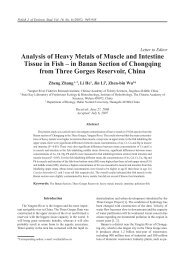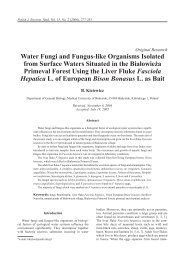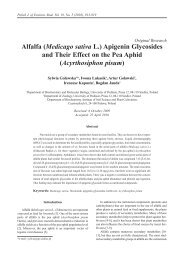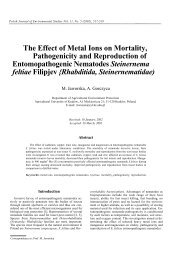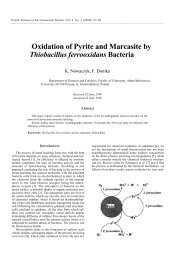Application of Ultrafiltration and Reverse Osmosis - Polish Journal of ...
Application of Ultrafiltration and Reverse Osmosis - Polish Journal of ...
Application of Ultrafiltration and Reverse Osmosis - Polish Journal of ...
Create successful ePaper yourself
Turn your PDF publications into a flip-book with our unique Google optimized e-Paper software.
<strong>Polish</strong> <strong>Journal</strong> <strong>of</strong> Environmental Studies Vol. 12, No. 3 (2003), 269-274<br />
Original Research<br />
<strong>Application</strong> <strong>of</strong> <strong>Ultrafiltration</strong> <strong>and</strong> <strong>Reverse</strong><br />
<strong>Osmosis</strong> to the Treatment <strong>of</strong> the Wastewater<br />
Produced by the Meat Industry<br />
J. Bohdziewicz*, E. Sroka, I. Korus<br />
Institute <strong>of</strong> Water <strong>and</strong> Wastewater Engineering, Silesian University <strong>of</strong> Technology<br />
ul.Konarskiego 18, 44-100 Gliwice, Pol<strong>and</strong><br />
Received: 14 November, 2002<br />
Accepted: 14 January, 2003<br />
Abstract<br />
The meat industry is characterized by high water consumption. Since this wastewater is highly loaded,<br />
it should be thoroughly pre-treated prior to its discharge into receiving water. Our investigations revealed<br />
that a hybrid system <strong>of</strong> ultrafiltration <strong>and</strong> reverse osmosis is a promising purification method. Its application<br />
resulted in a 100% <strong>and</strong> 98.8% removal <strong>of</strong> phosphorus <strong>and</strong> nitrogen compounds, respectively. The efficiency<br />
<strong>of</strong> COD <strong>and</strong> BOD removal exceeded 99%.<br />
Keywords: membranes, ultrafiltration, reverse osmosis, coagulant, wastewater produced by the meat<br />
industry<br />
Introduction<br />
One <strong>of</strong> the branches <strong>of</strong> the food industry which has the<br />
greatest impact on the degradation <strong>of</strong> the natural environment<br />
is the meat industry. Over 90% <strong>of</strong> the water taken<br />
for production needs is discharged as wastewater characterized<br />
by considerable content <strong>of</strong> organic matter, high<br />
COD <strong>and</strong> BOD 5<br />
, high concentration <strong>of</strong> etheric extract,<br />
suspension, biogenic <strong>and</strong> dissolved substances. For this<br />
reason, the wastewater should be thoroughly treated prior<br />
to its discharge into receiving water. This process, however,<br />
requires an application <strong>of</strong> several complementary<br />
technologies which enable the wastewater to be purified<br />
to the extent that will allow it to be reused in industry or<br />
discharged into receiving water.<br />
It should be emphasized that most meat-processing<br />
plants are equipped only with grease catchers, grates,<br />
*Corresponding author; e-mail: jolaboh@zeus.polsl.gliwice.pl<br />
sieves <strong>and</strong> floatation machines, <strong>and</strong> those which have a<br />
mechanical, chemical <strong>and</strong> biological wastewater treatment<br />
plant discharge wastewater which does not meet the<br />
st<strong>and</strong>ards [1].<br />
For the last few years, a lot <strong>of</strong> attention has been focused<br />
on the development <strong>of</strong> unconventional methods for<br />
wastewater treatment, such as pressure driven membrane<br />
operations, namely ultrafiltration which helps remove<br />
colloids, suspended <strong>and</strong> macromolecular matter, <strong>and</strong> reverse<br />
osmosis, which helps eliminate mineral substances<br />
<strong>and</strong> low-molecular organic compounds.<br />
This research dealt with the treatment <strong>of</strong> wastewater<br />
by means <strong>of</strong> two hybrid systems employing the following<br />
processes:<br />
1 - fat separation - floatation - filtration through a<br />
s<strong>and</strong> filter - ultrafiltration - reverse osmosis;<br />
2 - fat separation - floatation - coagulation - filtration<br />
through a s<strong>and</strong> filter - reverse osmosis.
270<br />
Material <strong>and</strong> Methods<br />
Apparatus<br />
<strong>Ultrafiltration</strong> was carried out applying a SEPA CF-<br />
HP pressure apparatus equipped with a plate-frame module<br />
produced by Osmonics, membrane active area - 155<br />
cm 2 . The system operated in the cross-flow mode.<br />
<strong>Reverse</strong> osmosis was conducted in a GH 100-400 highpressure<br />
apparatus, capacity – 400 cm 3 , produced by the<br />
same company. The system operated in the dead-end mode<br />
on flat membranes whose active area was 36.3 cm 2 .<br />
Materials<br />
The wastewater was sampled from the Meat-Processing<br />
Plant “UNILAG” in Wrzosowa (southern<br />
Pol<strong>and</strong>) whose activity covers the slaughter <strong>and</strong> processing<br />
<strong>of</strong> pigs. It was characterized by considerable<br />
pollutant load, substantial amounts <strong>of</strong> suspended matter<br />
<strong>and</strong> high concentrations <strong>of</strong> total nitrogen <strong>and</strong> phosphorus.<br />
The values <strong>of</strong> the basic <strong>and</strong> eutrophic pollution<br />
indexes ranged widely during the whole production<br />
cycle. The characteristics <strong>of</strong> the wastewater are presented<br />
in Table 1.<br />
Coagulant<br />
Our research employed the technical coagulant PIX-<br />
113 (Fe og<br />
- 12.8%, Fe 2+ - 0.7%, H 2<br />
SO 4<br />
- 1%) which was<br />
added to the wastewater in the form <strong>of</strong> 1% wt. aqueous<br />
solution. The basic reagent dosage <strong>of</strong> 6.5 g coagulant / g<br />
phosphorus in the wastewater was calculated on the basis<br />
<strong>of</strong> a chemical reaction <strong>of</strong> phosphates. The process <strong>of</strong> coagulation<br />
with the basic dosage <strong>of</strong> the coagulant as well as<br />
its 100% <strong>and</strong> 200% excess was carried out at 18 0 C - 20 0 C,<br />
pH <strong>of</strong> the wastewater being 6.4-7.6. The fast stirring time<br />
was 45 s, while the time <strong>of</strong> slow stirring <strong>and</strong> sedimentation<br />
was 30 min each. The degree <strong>of</strong> the wastewater purification<br />
was assessed on the basis <strong>of</strong> a decrease in COD<br />
<strong>and</strong> phosphorus concentration.<br />
Membranes<br />
Bohdziewicz J. et al.<br />
The membranes used in the pressure-driven membrane<br />
operations are as follows: flat polysulfone ultrafiltration<br />
membranes SEPA-H designated by HN <strong>and</strong> HZ,<br />
DS-CQ cellulose membrane, two DS-GH 2K <strong>and</strong> DS-GH<br />
8K composite membranes, <strong>and</strong> one SS-10 membrane for<br />
reverse osmosis made <strong>of</strong> cellulose acetate. Table 2 shows<br />
the operating conditions <strong>and</strong> separation characteristics<br />
recommended by the manufacturer <strong>of</strong> the membranes.<br />
Methods <strong>and</strong> Analysis<br />
In the first system which combined ultrafiltration<br />
with reverse osmosis the raw wastewater pre-treated<br />
in a fat separator, floatation machine <strong>and</strong> subsequently<br />
filtered through a 0.2 mm - 0.4 mm s<strong>and</strong> filter was<br />
subjected to ultrafiltration treatment which aimed at<br />
removing suspended <strong>and</strong> macromolecular matter. The<br />
processes, which used the HN, HZ, DS-GH 2K <strong>and</strong><br />
DS-GH 8K membranes, were carried out at the transmembrane<br />
pressures recommended by the manufacturer,<br />
while in the case <strong>of</strong> the DS-CQ membrane it was<br />
0.3 MPa. The linear flow velocity <strong>of</strong> the filtered medium<br />
over the membrane surface was 2m/s each time.<br />
The next stage was reverse osmosis. The operating parameters<br />
<strong>of</strong> the process were: transmembrane pressure<br />
- 2.0 MPa, stirring rate - 200 rpm. The effectiveness <strong>of</strong><br />
both processes was assessed based on the removal degree<br />
<strong>of</strong> the contaminants from the wastewater <strong>and</strong> the<br />
values <strong>of</strong> permeate fluxes.<br />
In the other system, ultrafiltration was replaced with<br />
coagulation followed by reverse osmosis carried out at the<br />
transmembrane pressure <strong>of</strong> 2.0 MPa <strong>and</strong> stirring rate <strong>of</strong><br />
200 rpm. The transport characteristics <strong>of</strong> the membranes<br />
were determined describing the dependence <strong>of</strong> the volume<br />
deionized water flux on the transmembrane pressure<br />
applied.<br />
The concentrations <strong>of</strong> total nitrogen, phosphorus <strong>and</strong><br />
COD were determined by means <strong>of</strong> the tests which used<br />
Table 1. Pollution concentration in raw wastewater.<br />
Pollution indices<br />
Concentration <strong>of</strong> pollution in raw wastewater<br />
[mg/dm 3 ]<br />
Load pollution<br />
[kg/d]<br />
Range Mean value Mean value<br />
Permissible<br />
st<strong>and</strong>ards [mg/dm 3 ]<br />
COD 2780 – 6720 4584 309.2 150<br />
BOD 5<br />
1200 – 3000 19721 126.8 30<br />
Total nitrogen 49 – 287 198 13 30<br />
Total phosphate 15 – 70 32 2.1 5*<br />
Total suspension 112 – 1743 396 26.1 50<br />
Detergents 7 – 21 11.3 0.75 5<br />
*For a wastewater treatment plant whose daily flow is below 2000 m 3 .
<strong>Application</strong> <strong>of</strong> <strong>Ultrafiltration</strong> <strong>and</strong> <strong>Reverse</strong> <strong>Osmosis</strong>... 271<br />
Table 2. Characteristics <strong>of</strong> membrane SEPA-CF firm Osmonics.<br />
Membrane type<br />
Retention<br />
(0.2% NaCl) R, [%]<br />
Nominal molecular<br />
weight Cut-<strong>of</strong>f<br />
Operating pressure ΔP, [MPa]<br />
Recommended<br />
Maximum<br />
Recommended<br />
pH range<br />
Max. temp.<br />
T, [ o C]<br />
HN - 20,000-70,000 0.35 2.07 0.5-13 100<br />
HZ - 80,000-100,000 0.17 1.38 0.5-13 100<br />
DS-GH 2K<br />
-<br />
2,000 - 2.7 2-11 90<br />
DS-GH 8K<br />
-<br />
8,000 - 2.7 2-11 90<br />
DS-CQ - 15,000-30,000 - 0.35 2-8 30<br />
SS-10 98* - 2.76 6.90 2-8 50<br />
* Value coefficient <strong>of</strong> retention appoint for ∆P = 27.6×10 6 Pa<br />
an SQ118 photometer produced by Merck [4]. BOD 5<br />
was assayed employing the respiratory measurement<br />
method with OxiTOP measuring cylinders produced by<br />
WTW [5], the dry matter <strong>of</strong> the deposit was determined<br />
by means <strong>of</strong> the gravimetric method whereas oxygen<br />
concentration, pH <strong>and</strong> temperature were measured with<br />
a CX - 315 microcomputer pH/oxygen meter produced by<br />
ELMETRON.<br />
Results <strong>and</strong> Discussion<br />
Treatment <strong>of</strong> Wastewater in the Hybrid System<br />
<strong>of</strong> Flotation, Filtration through a S<strong>and</strong> Filter,<br />
<strong>Ultrafiltration</strong> <strong>and</strong> <strong>Reverse</strong> <strong>Osmosis</strong>.<br />
Fig. 1 Dependence <strong>of</strong> volume water flux on transmembrane<br />
pressure for ultrafiltration membranes.<br />
The first stage <strong>of</strong> the investigations dealt with the<br />
treatment <strong>of</strong> wastewater in the system <strong>of</strong> ultrafiltration<br />
<strong>and</strong> reverse osmosis.<br />
Raw wastewater was introduced into an ultrafiltration<br />
module after fat separation, flotation <strong>and</strong> filtration<br />
through the s<strong>and</strong> filter. <strong>Ultrafiltration</strong> was carried out on<br />
four ultrafiltration membranes which differed in the polymer<br />
type they were made <strong>of</strong> <strong>and</strong> the compactness <strong>of</strong> the<br />
structure, <strong>and</strong> thus different cut-<strong>of</strong>f values ranging over<br />
2,000-100,000.<br />
At the beginning <strong>of</strong> our research, the transport characteristics<br />
<strong>of</strong> the membranes were determined by establishing<br />
the dependence <strong>of</strong> the volume deionized water flux on<br />
the transmembrane pressure. It was found that the volume<br />
water fluxes increased with increasing transmembrane<br />
pressure for all the cases, <strong>and</strong> the correlations observed<br />
were rectilinear (Fig.1).<br />
The highest increase in membrane performance over<br />
the pressure range <strong>of</strong> 0.1 MPa - 0.3 MPa was observed<br />
for the ultrafiltration DS-CQ membrane whose volume<br />
water flux increased 2.2-fold under these conditions. The<br />
DSGH-2K membrane was characterized by the slowest<br />
filtration velocity for which the volume water flux was<br />
0.31*10 -5 m 3 /m 2 ×s at ∆ = 0.3MPa.<br />
♦ HN + HZ DSCQ o DSGH-8K<br />
Fig. 2. Dependence <strong>of</strong> volume permeate flux on ultrafiltration<br />
time.<br />
Dependences <strong>of</strong> the volume permeate fluxes on filtration<br />
time are presented in Fig. 2.<br />
Table 3 presents equations describing the dependence<br />
<strong>of</strong> the volume permeate flux on the time <strong>of</strong> the process.<br />
They are <strong>of</strong> logarithmic nature.<br />
The HN membrane was the most efficient. Its permeate<br />
flux decreased by 12%, recovery being 30%. However, it<br />
was three times lower in comparison with the water flux.<br />
Decisively lower filtration velocities were found for the<br />
HZ <strong>and</strong> DS-CQ membranes. The volume permeate fluxes
272<br />
Bohdziewicz J. et al.<br />
Table 3. Equations describing the dependence <strong>of</strong> volume permeate flux on ultrafiltration time <strong>of</strong> raw wastewater.<br />
Membrane<br />
type<br />
J w<br />
=f(t)<br />
J w<br />
[m 3 /m 2 •s], t [s]<br />
Coefficient <strong>of</strong> correlation<br />
St<strong>and</strong>ard deviation<br />
HN J w<br />
=-0.0678ln(t)+1.9169 0.9326 0.06<br />
HZ J w<br />
=-0.1419ln(t)+1.6446 0.9726 0.12<br />
DSGH-8K J w<br />
=-0.1432ln(t)+1.8052 0.8965 0.08<br />
DSCQ J w<br />
=-0.098ln(t)+1.2625 0.9336 0.12<br />
Table 4. Pollution indexes <strong>of</strong> wastewater after treatment by the combination <strong>of</strong> ultrafiltration (HN membrane) <strong>and</strong> reverse osmosis (SS-<br />
10 membrane).<br />
Pollution indices<br />
Concentration <strong>of</strong><br />
pollution in raw<br />
wastewater<br />
[mg/dm 3 ]<br />
Wastewater after UF process [mg/dm 3 ] Wastewater after RO process [mg/dm 3 ]<br />
Concentration<br />
[mg/dm 3 ]<br />
Retention<br />
R [%]<br />
Concentration<br />
[mg/dm 3 ]<br />
Retention R [%]<br />
COD 2284 355.0 84.6 4.0 99.8<br />
BOD 5<br />
1900 350.0 81.5 3.9 99.8<br />
Total phosphate 25.5 10.6 58.4 0.0 100<br />
Total nitrogen 285 40.0 85.9 2.5 99.1<br />
Table 5. Equations describing the dependence <strong>of</strong> volume permeate flux on reverse osmosis time applying SS-10 membrane.<br />
Membrane type<br />
Wastewater after membrane<br />
HN<br />
J w<br />
=f(t)<br />
J w<br />
[m 3 /m 2 •s], t [s]<br />
Coefficient <strong>of</strong> correlation<br />
St<strong>and</strong>ard deviation<br />
J w<br />
=-0.0272ln(t)+0.7001 0.956 0.02<br />
Wastewater after membrane HZ J w<br />
=-0.0158ln(t)+0.573 0.8597 0.02<br />
Wastewater after membrane<br />
DSGH-8K<br />
Wastewater after membrane<br />
DSCQ<br />
J w<br />
=-0.0206ln(t)+0.5889 0.7804 0.01<br />
J w<br />
=-0.0224ln(t)+0.555 0.8951 0.02<br />
Fig. 3. Effect <strong>of</strong> ultrafiltration membrane type on the degree <strong>of</strong><br />
pollutant removal from wastewater.<br />
Fig. 4. Dependence <strong>of</strong> volume permeate flux on the time <strong>of</strong> reverse<br />
osmosis <strong>of</strong> the wastewater that underwent prior ultrafiltration.
<strong>Application</strong> <strong>of</strong> <strong>Ultrafiltration</strong> <strong>and</strong> <strong>Reverse</strong> <strong>Osmosis</strong>... 273<br />
Fig. 5. Dependence <strong>of</strong> pollutants removal degree on coagulant<br />
dose.<br />
Fig. 6. Dependence <strong>of</strong> volume permeate flux on the time <strong>of</strong> reverse<br />
osmosis <strong>of</strong> the wastewater additionally treated by means<br />
<strong>of</strong> combined coagulation <strong>and</strong> ultrafiltration (nz - concentration<br />
below detection threshold).<br />
obtained after 4 hours <strong>of</strong> the process were approximately<br />
3.9 times lower than for the HN membrane.<br />
However, the effectiveness <strong>of</strong> the processes depends<br />
not only on membrane performance but also the degree <strong>of</strong><br />
contaminant removal. Depending on the type <strong>of</strong> a membrane<br />
applied, different degrees <strong>of</strong> a decrease in particular<br />
pollution indexes (i.e. COD, BOD 5<br />
, phosphorus <strong>and</strong> total<br />
nitrogen) (Fig. 3) were found.<br />
The highest retention coefficients <strong>of</strong> nitrogen <strong>and</strong><br />
phosphorus, <strong>and</strong> the highest COD <strong>and</strong> BOD 5<br />
were obtained<br />
when the DS-CQ membrane was applied. They<br />
were 58%, 85.9%, 84.6% <strong>and</strong> 81.5%, respectively. A<br />
similar degree <strong>of</strong> wastewater purification was obtained<br />
in the ultrafiltration carried out on the HN membrane.<br />
Nevertheless, the degrees obtained in both cases were<br />
not sufficient to allow the wastewater to be discharged<br />
into receiving water, let alone be returned into the production<br />
cycle. For this reason, the ultrafiltration permeates<br />
obtained were subjected to additional purification<br />
applying reverse osmosis. Table 4 shows the final characteristics<br />
<strong>of</strong> the wastewater treated in the hybrid system<br />
<strong>of</strong> both processes.<br />
The results obtained indicate that the wastewater additionally<br />
treated during reverse osmosis can be reused in<br />
the production cycle.<br />
Fig. 4 illustrates dependences <strong>of</strong> the changes in the volume<br />
permeate fluxes on the time <strong>of</strong> reverse osmosis after<br />
ultrafiltration treatment carried out on the membranes tested.<br />
The decrease in filtration velocity for the HN, HZ <strong>and</strong> DS-<br />
GH 8K membranes was similar <strong>and</strong> reached 12%, while for<br />
DS-CQ it decreased almost two-fold <strong>and</strong> equalled 6.5%.<br />
As far as reverse osmosis is concerned, the dependences<br />
<strong>of</strong> the volume permeate flux on time were <strong>of</strong><br />
logarithmic function, similarly to the ultrafiltration <strong>of</strong> raw<br />
wastewater (Table 5).<br />
Treatment <strong>of</strong> Wastewater in the Hybrid System <strong>of</strong><br />
Coagulation <strong>and</strong> <strong>Reverse</strong> <strong>Osmosis</strong><br />
Since ultrafiltration did not produce a satisfactory<br />
degree <strong>of</strong> wastewater purification, it was replaced with<br />
coagulation. The most favourable results were obtained<br />
for the 200% excess <strong>of</strong> the basic coagulant dosage i.e.<br />
PIX concentration <strong>of</strong> 13.5 g coagulant/g phosphorus. It<br />
enabled a decrease in pollution indexes COD <strong>and</strong> BOD 5<br />
by 92.6% <strong>and</strong> 87.5% respectively. The concentrations <strong>of</strong><br />
phosphorus <strong>and</strong> total nitrogen in the purified wastewater<br />
decreased by 91% <strong>and</strong> 64% (Fig. 5).<br />
Subsequently, following the coagulation, the wastewater<br />
was additionally passed through a s<strong>and</strong> filter prior<br />
Table 6. Effectiveness <strong>of</strong> wastewater treatment in the system combining coagulation <strong>and</strong> reverse osmosis.<br />
Pollution indices<br />
Concentration <strong>of</strong><br />
pollution in raw<br />
wastewater<br />
[mg/dm 3 ]<br />
Wastewater after coagulation process<br />
[mg/dm 3 ]<br />
Concentration<br />
Retention R [%]<br />
[mg/dm 3 ]<br />
Wastewater after RO process [mg/dm 3 ]<br />
Concentration<br />
[mg/dm 3 ]<br />
Retention R [%]<br />
COD 2700 662.0 87.5 4.00 99.9<br />
BOD 5<br />
5318 200.0 62.6 3.98 99.2<br />
Total nitrogen 420,0 150.0 49.0 1.16 98.8<br />
Total phosphate 27,8 2.5 91.0 0.0 100
274<br />
to its introduction into the osmotic module. The effectiveness<br />
<strong>of</strong> the wastewater treatment in the system discussed<br />
is shown in Table 6.<br />
Fig. 6 illustrates a comparison <strong>of</strong> the volume osmotic<br />
permeate fluxes obtained during the final stage <strong>of</strong> wastewater<br />
purification after its initial treatment in the process<br />
<strong>of</strong> coagulation.<br />
After six hours <strong>of</strong> reverse osmosis in which the feed<br />
was the wastewater that underwent prior ultrafiltration, the<br />
permeate flux was higher by 43% compared to the flux obtained<br />
in the process in which the pressure filtration dealt<br />
with the wastewater that underwent prior coagulation. In<br />
this case, a smaller decrease in the volume permeate flux<br />
during reverse osmosis was also observed. It reached 4.3%<br />
<strong>and</strong> was lower by 22.7% than the decrease in the permeate<br />
flux for the wastewater after prior coagulation. This<br />
rapid drop in filtration velocity could be explained by the<br />
presence <strong>of</strong> suspended matter which was not removed sufficiently<br />
during the filtration through the s<strong>and</strong> filter.<br />
Conclusions<br />
The investigations proved that the pressure driven<br />
membrane operations can be applied to the treatment <strong>of</strong> the<br />
Bohdziewicz J. et al.<br />
wastewater from the meat industry. It has been found that<br />
the degree <strong>of</strong> wastewater purification, both after ultrafiltration<br />
<strong>and</strong> coagulation, is too low to discharge the wastewater<br />
into receiving water. Only the application <strong>of</strong> reverse osmosis<br />
enables it to be reused in the production cycle.<br />
References<br />
1. KRAJEWSKA, Treatment <strong>of</strong> the wastewater from the Meat<br />
Plant FARM FOOD S.A.. Czyżewo Branch, Conference<br />
h<strong>and</strong>outs <strong>of</strong> the <strong>Polish</strong> Scientific <strong>and</strong> Technological Conference<br />
entitled „Achievements <strong>and</strong> problems concerning the<br />
treatment <strong>of</strong> industrial wastewater” (in <strong>Polish</strong>), Politechnika<br />
Śląska, pp. 49-58, 1998<br />
2. Regulation <strong>of</strong> the Ministry <strong>of</strong> Environmental Protection,<br />
Natural Resources <strong>and</strong> Forestry dated 5 November 1991<br />
on the classification <strong>of</strong> waters <strong>and</strong> conditions the sewage<br />
discharged to waters <strong>and</strong> soil should satisfy, <strong>Journal</strong> <strong>of</strong> Law<br />
No. 116, item 501.<br />
3. Performance characteristic <strong>of</strong> reserve osmosis, nonfiltration<br />
<strong>and</strong> ultrafiltration spiral wound permeates – Osmonics.<br />
4. User’s manual, Photometer SQ 118, Merck.<br />
5. User’s manual, Determination <strong>of</strong> BZT using respirometric<br />
method, Oxi Top, firm WTW.<br />
6. HERMANOWICZ W (Edit.), Physicochemical testing <strong>of</strong><br />
water <strong>and</strong> sewage, Arkady, Warsaw 1998.


